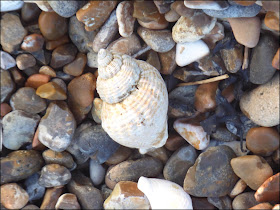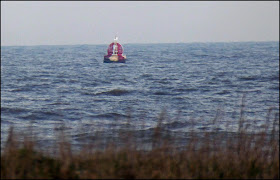There are times when you learn as much about wildlife by failing to see something (and sadly the crab above will never again see out of these vacant eye sockets) as by spotting a bird or animal successfully at a given place.
We have been on a Short-Eared Owl quest for some weeks, having enjoyed wonderful photos taken by others of this bird we have yet to see for the first time. Once again it eluded us this afternoon.
But the desire to look made us go out in the cold to see what was about. We noticed a few Cormorants in formation and a Little Egret in a brackish stream. There were gulls and corvids.
We scanned the sea at Shingle Street for seals, but there were no seal heads bobbing about today. However, there are always unexpected treasures on a beach... such as the mermaid's purse, the oyster shell and whelk in the pictures below.
Shingle Street is an evocative place, out on 'the edge'. It was particularly eerie this afternoon with the fading light, the empty shore and above all the tolling of the bell. But this was not Dunwich where some are sure that they have heard the bells from the succession of churches claimed by the tide. This bell off Shingle Street resides in the buoy in the next photo, warning all within earshot of the perilous Orfordness sandbanks. It brought to mind words from a poem I encountered at school many years ago, 'The Inchcape Rock', by Robert Southey. Here is the verse that rang in my ear:
The Abbot of Aberbrothok
Had placed that bell on the Inchcape Rock;
On a buoy in the storm it floated and swung,
And over the waves its warning rung.
You can read more about the Inchcape Rock and the lighthouse here. The poignant fact, from my point of view, is that while Inchcape is many miles from here, off the east coast of Scotland, the distinctive red and white lighthouse at Orfordness, recently abandoned to its watery fate, can still be seen from Shingle Street.
We waited for the sun to set, then turned for home, passing a couple of deer on the way.
The photo above shows the shoreline and the one below, the flat meadow and marsh on the landward side of the Shingle Street lane.
- Details of Blake Morrison's poetry collection, Shingle Street
- Details of Knowing you Place - Wildlife in Shingle Street by Jeremy Mynott, a booklet (I have just bought) on the wildlife in this unique corner (or edge) of the Suffolk coast







Open grassland seems to be the best place for SEOs...but then how would I know as I've never seen one!
ReplyDeleteYou reminded me of the buoy that we saw and heard along the Maine coastline. It is a little sad to hear from far off in the water. Your rocks in the background were perfect for the shells and crab that you photographer
ReplyDeleteWhat a lovely post - so often I'm taken on an unrelated adventure when looking out for something. Loved the poem about the Abbot and the journal from Bell Rock Lighthouse.
ReplyDeleteLast winter about 15 SEOs spent the winter at Musselburgh and I saw them several times. I've never seen any there any other year..... (I had seen them previously on Orkney though)
ReplyDeleteA very evocative post - sorry you didn't get to see the owls but hopefully you will one day soon. Love the photos of your finds on the shingle.
ReplyDeleteI've only ever seen a SEO once - out at RSPB Middleton Lakes a few years back. When you see one it will be worth the wait :)
Lovely post and some nice finds, well worth the walk out. Owls next time.. fingers crossed.
ReplyDeleteAmanda xx
Sorry you didn't get any owls but you did get some fabulous photographs to share here.
ReplyDeleteWhat an enjoyable walk you had.
All the best Jan